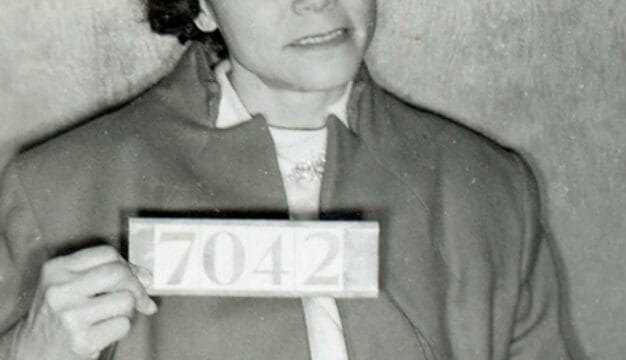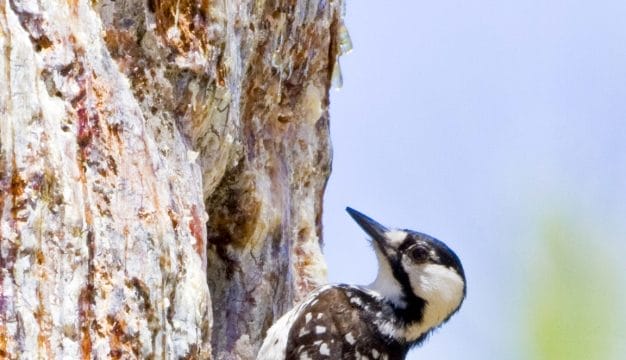Russell Cave
 Russell Cave National Monument
Russell Cave is located in northeast Alabama near the town of Bridgeport in Jackson County. It is a significant archaeological site that provides a record of thousands of years of human use. Russell Cave was named a National Monument in 1961 and a placed on the National Register of Historic Places in 1966. Today, the cave is part of the national park system and hosts visitors from all over the world. Russell Cave is a stop on the North Alabama Birding Trail. It is named for the Russell family, which for many generations owned the land surrounding the cave.
Russell Cave National Monument
Russell Cave is located in northeast Alabama near the town of Bridgeport in Jackson County. It is a significant archaeological site that provides a record of thousands of years of human use. Russell Cave was named a National Monument in 1961 and a placed on the National Register of Historic Places in 1966. Today, the cave is part of the national park system and hosts visitors from all over the world. Russell Cave is a stop on the North Alabama Birding Trail. It is named for the Russell family, which for many generations owned the land surrounding the cave.
Geology
Russell Cave is located in what is known as the TAG area because it encompasses portions of southeastern Tennessee, northern Alabama, and southwestern Georgia. This area, contained within the Cumberland Plateau, is rich in a type of geological environment known as karst topography, which is characterized by carbonate rock (such as limestone or dolomite) that has been eroded to varying degrees by water. Caves are a common feature of the erosion process, and Russell Cave, like other caves in the region, was formed when groundwater eroded cracks and fissures in Mississippian limestone beds. Russell Cave is part of a larger system of interconnected, tubular caves that stretch approximately seven miles. These caves carry run-off water from Doran Cove, the valley where Russell Cave is located.
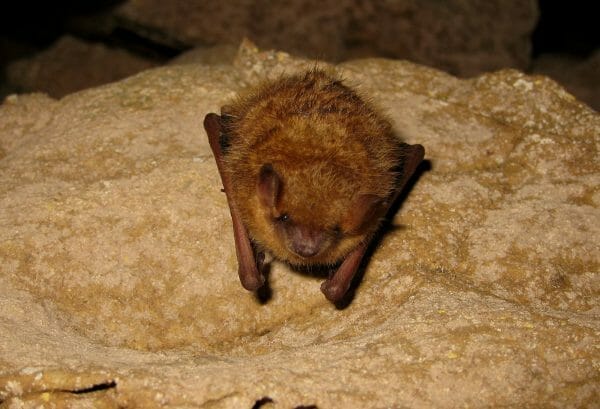 Tri-colored Bat in Russell Cave
Approximately 11,000 years ago, the entrance to Russell Cave was created when a sinkhole developed on the site. At the time, the floor to Russell Cave was at water level and prone to regular flooding, thus making it difficult for humans to use the cave regularly. By approximately 9,000 years ago, rockfalls from the cave ceiling raised the floor above the water line, and humans began using Russell Cave to escape from north winds during the colder months. The cave’s location was convenient to water and to the lower parts of Doran Cove, where game was abundant. Additionally, the limestone from which Russell Cave was carved contained nodules of chert, a type of rock that is easily worked into tools and sharp projectile points.
Tri-colored Bat in Russell Cave
Approximately 11,000 years ago, the entrance to Russell Cave was created when a sinkhole developed on the site. At the time, the floor to Russell Cave was at water level and prone to regular flooding, thus making it difficult for humans to use the cave regularly. By approximately 9,000 years ago, rockfalls from the cave ceiling raised the floor above the water line, and humans began using Russell Cave to escape from north winds during the colder months. The cave’s location was convenient to water and to the lower parts of Doran Cove, where game was abundant. Additionally, the limestone from which Russell Cave was carved contained nodules of chert, a type of rock that is easily worked into tools and sharp projectile points.
Biology
In addition to its former human inhabitants, Russell Cave also provides shelter for a number of animal species. Permanent residents include fish and insects common to cave environments. Part-time residents to the park include eight species of bat. Species that live in the cave are the big brown, little brown, gray bat, northern bat, tri-colored bat, and Rafinesque’s big-eared bat. Species that roost in trees on the park property are the eastern red bat and evening bat. The surrounding acreage is home to various snakes and other reptiles; mammals typical of woodland environments, including white-tailed deer, foxes, and rabbits, and numerous bird species. Visitors to the North Alabama Birding Trail stop at the cave have recorded some 115 bird species.
Human Use of Russell Cave
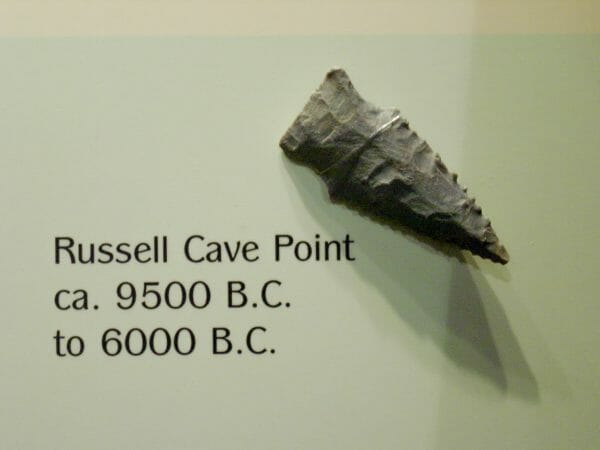 Archaic Projectile Point
Native Americans from the Archaic period to the historic era occupied Russell Cave. Animal and plant remains found in the cave show that the diet of the cave’s inhabitants remained roughly the same over this long time period. Researchers have found remains of mammals, birds, reptiles, fish, and mollusks, with deer, turkey, and squirrel being the most common. These animals still are hunted commonly in Alabama.
Archaic Projectile Point
Native Americans from the Archaic period to the historic era occupied Russell Cave. Animal and plant remains found in the cave show that the diet of the cave’s inhabitants remained roughly the same over this long time period. Researchers have found remains of mammals, birds, reptiles, fish, and mollusks, with deer, turkey, and squirrel being the most common. These animals still are hunted commonly in Alabama.
Preliminary research on the findings at Russell Cave indicated that Native Americans only used the cave during the winter months, but more analysis is required to confirm that theory. It is likely, however, that Native Americans came to use the cave more as a hunting camp when agriculture became a more common way of life during the Woodland period. Indeed, each excavated layer within the cave contains only a few artifacts, supporting the view that the cave was inhabited only sporadically and by small groups of 30 people or fewer.
Archaic Period (approximately 10,500 to 3,000 years before the present). In the lowest levels of excavations at the cave, which date to approximately 6,550 years ago, archaeologists have found stone projectile points used for hunting as well as the charcoal remains of firepits. They have also found several burials containing human remains that may date back more than 8,000 years. Although only stone tools have survived, Native Americans of this period likely used bone and horn tools and transported and stored their food in woven baskets, but no evidence of such organic material has survived. They hunted game such as deer and turkey, fished in nearby streams and the Tennessee River, and gathered plants, roots, and berries that grew in the area. During this period, Native Americans began using a device known as the atlatl, a carved stick with a curved and hollowed out end that held the end of a spear. This device allowed the user to throw a spear with much more force and distance than simply throwing the spear alone by hand. Evidence of atlatls has been recovered from Russell Cave; the National Park Service entrance sign depicts a Native American using an atlatl.
Of particular interest in the evidence found at Russell Cave are the remains of Mylohyus, an extinct genus of peccary. Bones of these wild pig relatives recovered from Russell Cave date from the Early Archaic period and indicate that animals in this genus survived beyond the Ice Age and were hunted by humans. Russell Cave was the first place Mylohyus remains were discovered in Alabama. Many researchers believe that humans played a role in the extinction of many large mammals in North America.
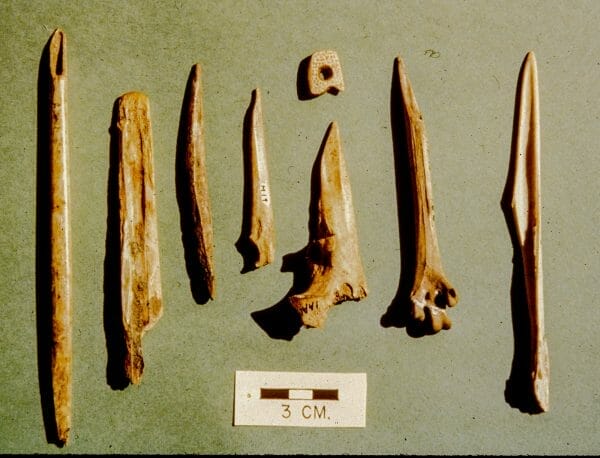 Woodland Period Bone Tools
Woodland Period (approximately 3,000 to 1,000 years before the present). During this period, Native Americans in the Southeast began to use the bow and arrow and make pottery. Russell Cave has produced both stone arrow points and pottery sherds from this period. Archaeologists have also uncovered evidence for the early domestication of plants in the form of a cache of Chenopodium seeds, although there is some debate about whether this evidence actually dates to the Late Archaic. These seeds are important because they indicate that Native Americans in the southeastern United States were starting to cultivate plants deliberately some 1,000 years before the domestication of maize in Mexico.
Woodland Period Bone Tools
Woodland Period (approximately 3,000 to 1,000 years before the present). During this period, Native Americans in the Southeast began to use the bow and arrow and make pottery. Russell Cave has produced both stone arrow points and pottery sherds from this period. Archaeologists have also uncovered evidence for the early domestication of plants in the form of a cache of Chenopodium seeds, although there is some debate about whether this evidence actually dates to the Late Archaic. These seeds are important because they indicate that Native Americans in the southeastern United States were starting to cultivate plants deliberately some 1,000 years before the domestication of maize in Mexico.
Mississippian Period (approximately 1,000 years before the present to ca. 1550). By this time, Native Americans in the Southeast were shifting away from hunting and gathering and toward living in settlements based on agriculture. Russell Cave was still used but more sporadically and probably only by hunters during the winter months when the growing season had ended. By the time Europeans began settling in the area in the late eighteenth century, the region was occupied by the Cherokees, who used the cave infrequently. A metal fishhook found in the cave offers some evidence of continued use after European contact.
National Monument History
 Russell Cave Interior
In 1953, the Chattanooga chapter of the Tennessee Archeological Society first recognized Russell Cave as an archaeological site. The first explorations revealed layers of deposits in the cave floor. The National Geographic Society purchased 310 acres of farmland surrounding the site from Oscar Ridley in 1956 and conducted additional excavations, as did the Smithsonian Institution and the National Park Service. The National Geographic Society donated the cave and surrounding acreage to the U.S. government in 1961, and Pres. John F. Kennedy proclaimed Russell Cave a National Monument on May 11 of that year.
Russell Cave Interior
In 1953, the Chattanooga chapter of the Tennessee Archeological Society first recognized Russell Cave as an archaeological site. The first explorations revealed layers of deposits in the cave floor. The National Geographic Society purchased 310 acres of farmland surrounding the site from Oscar Ridley in 1956 and conducted additional excavations, as did the Smithsonian Institution and the National Park Service. The National Geographic Society donated the cave and surrounding acreage to the U.S. government in 1961, and Pres. John F. Kennedy proclaimed Russell Cave a National Monument on May 11 of that year.
To date, archaeological teams have excavated more than 30 feet down into the cave floor. Because they found the remains of ancient campfires, they were able to use carbon-14 dating to determine the age of the fires and thus surmise the age of the associated artifacts. As noted previously, the earliest evidence found at the cave gave a carbon-14 date of around 6,500 years ago, but some of the human remains may be much older.
As archaeologists explored Russell Cave, they mapped out sections on the cave floor and meticulously dug down through the layers of human occupation. As they excavated, they recorded the exact location and depth of all the evidence to associate it with a particular period of occupation. Since the first excavations, human burials and thousands of artifacts have been discovered. Some of the burials date from the earliest use of the cave. From these remains, scientists have a better understanding of what these early people looked like, their size, and their nutrition. Weapons and tools recovered from the site allow archaeologists to trace the progression of early technology. For example, atlatls and spear points shifted to arrow points between the Archaic and Woodland periods. Pottery sherds indicate that Native Americans had developed the ability to harden their clay vessels with heat; evidence of earlier types of pottery did not survive because it was less durable.
Contemporary Russell Cave
 Russell Cave Exhibit
Russell Cave continues to be an extremely important archaeological research site, but it also is a popular tourist destination. Visitors from all over the United States and many other countries tour the cave each year. The visitor center includes a museum that contains displays of artifacts found at the site and leads visitors through a timeline of the cave’s human history. Also, park rangers demonstrate the various ways that the cave’s inhabitants would have used their tools and weapons, and the park hosts a Native American festival each spring. The site is also part of the North Alabama Birding Trail for visitors who are interested in bird watching. Visitors can also enjoy the picnic area, a 1.5 mile hiking trail, and a bookstore.
Russell Cave Exhibit
Russell Cave continues to be an extremely important archaeological research site, but it also is a popular tourist destination. Visitors from all over the United States and many other countries tour the cave each year. The visitor center includes a museum that contains displays of artifacts found at the site and leads visitors through a timeline of the cave’s human history. Also, park rangers demonstrate the various ways that the cave’s inhabitants would have used their tools and weapons, and the park hosts a Native American festival each spring. The site is also part of the North Alabama Birding Trail for visitors who are interested in bird watching. Visitors can also enjoy the picnic area, a 1.5 mile hiking trail, and a bookstore.
Efforts are underway to create three-dimensional digital representations of artifacts that cannot be stored physically at the museum, and the cave is being surveyed for the possibility of new excavations. Climatology research is also ongoing at the site so that scientists and visitors to the cave will be able to understand more about what the climate was like during the many periods of Russell Cave’s human habitation.
Further Reading
- Fogelson, Raymond D. Handbook of North American Indians. Vol. 14, Southeast. Washington, D.C.: Smithsonian Institution, 2004.
- Griffin, John W. Investigations in Russell Cave, Russell Cave National Monument, Alabama. Publication in Archeology 13. Washington, D.C.: National Park Service, 1974.
- Johnson, Jay K., ed. The Development of Southeastern Archeology. Tuscaloosa: University of Alabama Press, 1993.
- Sassaman, Kenneth E. and David G. Anderson, eds. Archaeology of the Mid-Holocene Southeast. Gainesville: University Press of Florida, 1996.
- Walthall, John A. Prehistoric Indians of the Southeast: Archaeology of Alabama and the Middle South. Tuscaloosa: University of Alabama Press, 1980.
